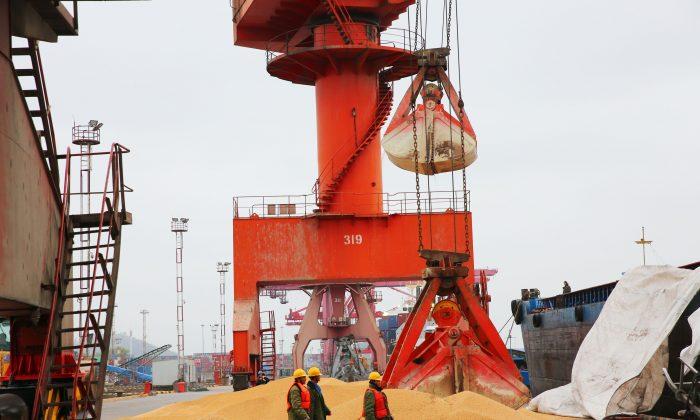Unusually frosty weather has led to a precipitous drop in China’s domestic soybean production, adding to trade war woes.
Chinese soybean production has dropped precipitously as unusually frosty weather hit key agricultural regions in early September, damaging more than 2.5 million acres of soybean fields and reducing the harvest by an estimated 300,000 tons in the northeastern province of Heilongjiang.
The downturn comes as China maintains tariffs on soybeans imported from the United States as part of the escalating Sino–U.S. trade war.
On Sept. 17, China’s Ministry of Agriculture and Rural Affairs reported that northwestern Heilongjiang had experienced low temperatures and early frost between Sept. 9 and Sept. 10, damaging the harvest. According to the National Meteorological Center of China Meteorological Administration, over the past 50 years, the Heilongjiang frost hasn’t usually begun until late September, making the latest weather an unusual event.
Soybeans grow ideally in temperatures between 68 and 77 degrees Fahrenheit. In the production period between May and September, a two-degree reduction in average temperature reduces the yield by acre by over a hundred pounds; frost is especially damaging. Import Reliance
On Aug. 10, Reuters quoted a Chinese agricultural official as saying that Chinese soybean production typically falls short of demand by over 90 million tons, and that it relies on imports to make up the rest. In 2017, China consumed more than 110 million tons, of which it imported 95.53 million tons, or 87 percent of total consumption. In April, local authorities in Heilongjiang and Jilin, a neighboring province, issued ordinances requiring farmers to expand their soybean production, and significantly increased subsidies for the crop. The subsidy per Chinese mu (0.165 acres) of soybeans is now 100 yuan (about $15) higher than that for corn.
The United States has been China’s primary supplier of soybeans, but exports of the product have decreased since the beginning of the Sino-U.S. trade war this spring.
The Chinese Communist Party (CCP) has been attempting to use the soybean trade to counter U.S. tariffs introduced by the Trump administration to punish Beijing for its longstanding unfair or illegitimate business practices. The CCP has imposed a 25 percent tariff on U.S. soybeans.
In mid-July, Shao Zhongyi, known as the “king of soybeans” and owner of Shandong Chenxi Group Company Ltd., filed for bankruptcy. Formerly the richest man in Shandong Province, eastern China, Shao owned 19 billion yuan ($2.77 billion).
Japanese business newspaper, the Nikkei, published a July 31 report analyzing the reasons for the company’s bankruptcy. Low demand for soybean meal had damaged the company’s business, and due to the CCP’s tightening of monetary policy, the company’s capital turnover had deteriorated. Finally, as the cost of imported soybeans rose, the company could no longer maintain its operations, Nikkei reported.
In the past year, from Shandong to the southern province of Guangxi, at least 20 soybean crushers have reduced or halted production.Price Hike
But with the trade tariffs on U.S. soybeans in place, China faces a supply shortage. Soybean imports dropped in July, causing China’s soybean and soymeal prices to
increase rapidly.
Brazil, the world’s largest soybean exporter, is set to finish its harvest and sell out its crop. Typically, China will then buy U.S. soybeans, which begin harvesting in the fall. Without those soybeans, China, as the world’s biggest consumer of the crop, is in trouble.
“Now that we are getting close to the U.S. soybean season (in September), news like the trade war escalation and falling imports will have a bigger impact on prices,” Pan Tiantian, analyst with Zheshang Futures, told Reuters. The United States is China’s second-largest supplier of soybeans.
Some analysts believe China will still need to import U.S. soybeans—and pay those tariffs—in order to fill its supply gap.
“Brazil and Argentina are unable to supply all of China’s needs, especially after both a drought that led to a 40 percent year-on-year fall in Argentine production, and freight issues in Brazil,” according to a
Morgan Stanley report released in August.
“Therefore, in the medium term, China is likely to continue to depend on U.S. imports and the [price] discount of Chicago versus South America should narrow going forward,” the report stated, referring to prices in the futures market.
Reuters contributed to this report.




